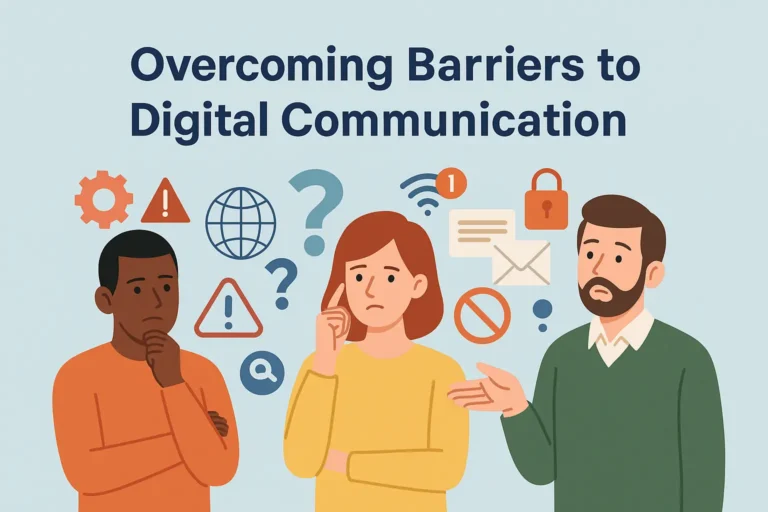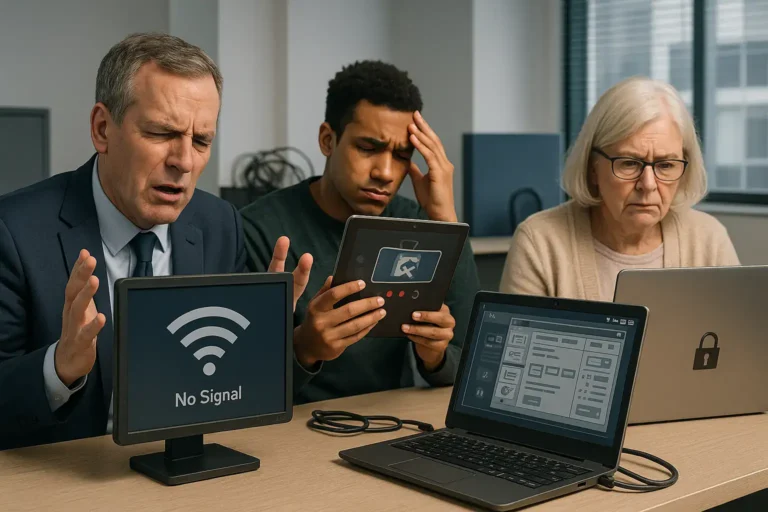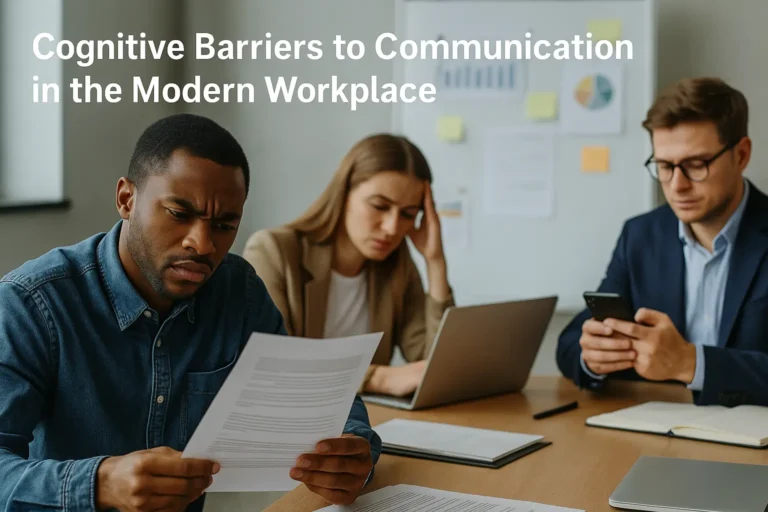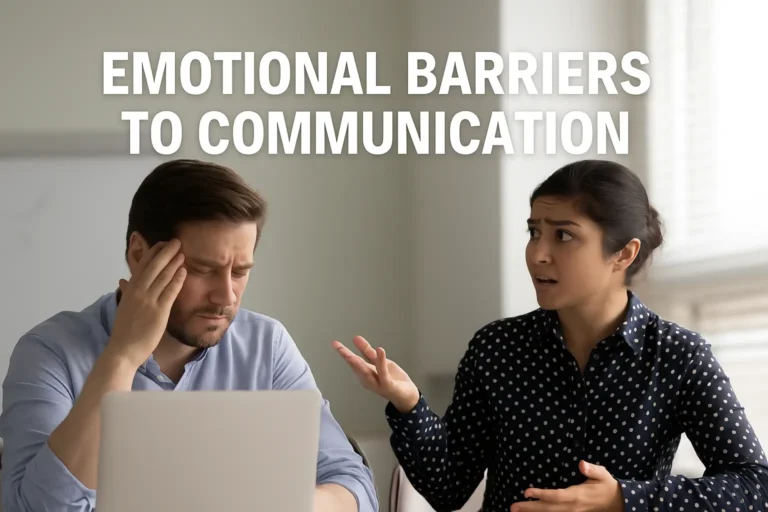Filtering Barriers to Communication
Have you ever walked away from a conversation feeling misunderstood or frustrated? Maybe you sent an email, but the response missed your point. These problems are more common than you think, and they often come down to filtering barriers in communication. Filtering barriers are those invisible walls that distort, block, or change our messages, leaving room for misinterpretation, missing details, and even conflict.
Understanding what filtering barriers are and how they affect our daily conversations—whether at work, home, or online—can make a huge difference in how effectively we connect. In this article, we’ll uncover the main types of filtering barriers to communication, reveal their impact, and share practical steps you can use to overcome them. If you want to improve your relationships, avoid unnecessary misunderstandings, and build trust, read on.
What Are Filtering Barriers to Communication?
Filtering barriers in communication refer to any process that alters or blocks a message as it travels from sender to receiver. This “filtering” can happen intentionally or unintentionally and is shaped by factors like emotions, biases, social media algorithms, information overload, and even censorship.
Filtering often creeps in at different points:
- Source Filtering: When the sender changes, edits, or leaves out parts of the message due to personal bias, emotional state, or intent.
- Encoding Filtering: When the sender’s word choice or lack of clarity makes it hard for the receiver to understand the original message.
- Receiver Filtering: When the person on the other end interprets or selects only certain parts of the message, often due to their own experiences or emotions.
Why Do Filtering Barriers Matter?
Filtering barriers matter because they get in the way of true understanding. They can lead to confusion, frustration, broken trust, and lost opportunities—especially in workplaces, online communities, and personal relationships. Even with the best intentions, these invisible barriers can turn clear communication into a game of telephone, where the original meaning gets lost along the way.
Common Types of Filtering Barriers
Emotional Filtering
Emotions play a huge role in communication. When we feel anxious, angry, or defensive, we might unintentionally distort messages—either by watering them down, exaggerating, or leaving out important details. Imagine a manager giving feedback while feeling frustrated. The words might come out harsher than intended, causing the employee to focus on the tone rather than the actual advice.
Information Overload
Today, we are flooded with information—emails, texts, notifications, meetings, and social media updates. When too much information comes at once, our brains can’t process it all. Important details get filtered out, and we end up missing crucial parts of the message.
Selective Perception
Selective perception is when we focus only on information that fits our beliefs, interests, or needs, while ignoring the rest. This bias can affect how we interpret conversations, leading to misunderstandings. For example, two coworkers hear the same announcement. One takes it as positive news, the other as a threat—simply because of their own perspectives.
Social Media Filters and Algorithms
Social platforms use algorithms to show us content they think we’ll like, based on our behavior. While this can be convenient, it also narrows our exposure to new ideas and reinforces existing beliefs—making it harder to get unfiltered, balanced information. This “echo chamber” effect can limit real dialogue and mutual understanding.
Censorship and Information Control
Filtering barriers also appear as intentional censorship, where information is edited, removed, or blocked before it ever reaches the audience. This happens on social media, in organizations, and in some countries at a much larger scale. Censorship doesn’t just hide facts—it shapes how people think and respond.
Language and Encoding Filtering
Sometimes, the words we choose create confusion. Jargon, slang, complex vocabulary, or even simple mistakes can block understanding. Encoding filtering happens when the sender’s message isn’t clear or tailored to the audience.
How Filtering Barriers Affect Communication
Filtering barriers aren’t just a nuisance—they can cause real problems.
- Lost Trust: When people sense they’re not getting the full story, trust breaks down.
- Missed Opportunities: Important feedback, ideas, or warnings may never reach the right person.
- Workplace Conflict: Filtering can lead to rumors, grapevine gossip, and team misalignment.
- Personal Frustration: Feeling misunderstood wears down relationships over time.
Strategies for Overcoming Filtering Barriers
Now that we know what filtering barriers look like, how can we reduce their impact?
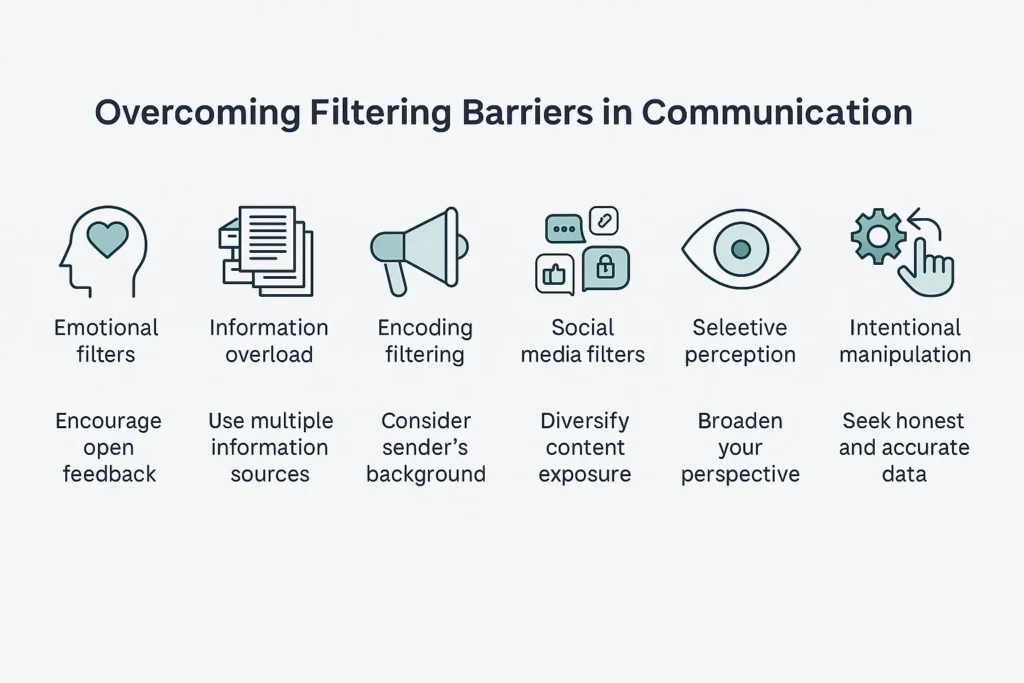
Diversify Your Information Sources
Don’t rely on just one channel or person for important news. Cross-check messages using multiple sources—team meetings, email, written summaries, and informal chats. This helps ensure no crucial detail gets filtered out.
Practice Active Listening and Feedback
Ask clarifying questions and invite feedback. When someone is speaking, listen fully without interrupting. Repeat back what you heard in your own words to confirm understanding. This creates a feedback loop, which is essential for catching filtered or distorted messages.
Encourage Open and Honest Communication
Create a culture where people feel safe sharing their real thoughts and feelings. Leaders should model transparency, admit mistakes, and encourage questions. When people feel heard, there’s less need for filtering or editing the truth.
Use Clear, Simple Language
Avoid jargon or technical terms unless everyone understands them. Tailor your message to your audience’s background, and when in doubt, ask if clarification is needed.
Manage Information Overload
Limit the number of messages sent at once. Use bullet points, short paragraphs, and bold text for important deadlines or instructions. Consider using project management tools to track and highlight key information instead of relying solely on email.
Be Aware of Emotional and Cognitive Filters
Before sending a message, check in with yourself. Are you feeling stressed, rushed, or upset? If so, wait until you’re calmer, or ask someone to review your message. On the receiving end, pause before reacting, and ask clarifying questions if something seems off.
Challenge Social Media Algorithms
Step outside your online “bubble” by following accounts or reading news from different viewpoints. Use fact-checking resources and critically examine viral content.
Address Censorship Proactively
If you suspect information is being withheld, ask direct questions or seek alternative sources. Encourage open forums for feedback where employees or participants can anonymously share concerns.
Filtering Barriers in the Digital World
The rise of remote work and digital tools has made filtering barriers even more complex. Virtual meetings, group chats, and social platforms all have their own ways of filtering and shaping messages.
- Virtual meetings: Technical glitches, mute buttons, or multitasking can filter out vital nonverbal cues or side comments.
- Emails: Tone can be hard to read, and important messages can get buried.
- Social media: Censorship and algorithmic filtering change what content is seen or hidden.
To counteract these issues, make use of multiple communication channels, provide written follow-ups after meetings, and invite private feedback to ensure everyone’s voice is included.
Conclusion
Filtering barriers to communication are everywhere, from the workplace to social media and even our closest relationships. But these barriers don’t have to control our conversations. By learning to spot them, using simple language, and encouraging honest feedback, you can dramatically improve your ability to connect and be understood.
Clear, open communication is the key to better teamwork, stronger relationships, and less frustration. Make it your goal to notice when filters are in play, and use the strategies above to break through.

